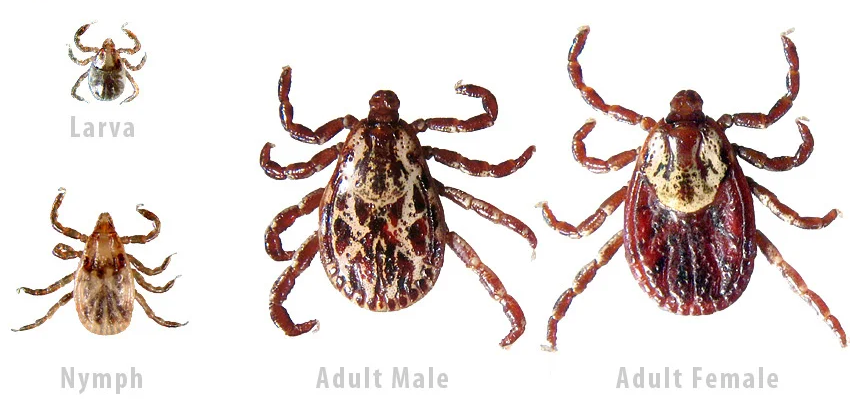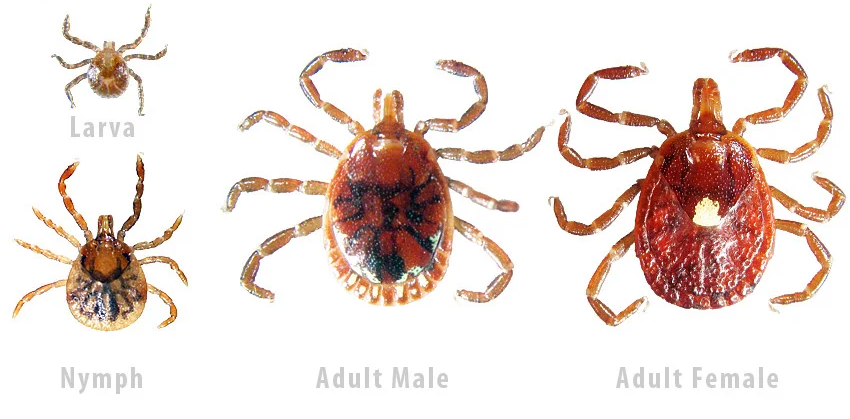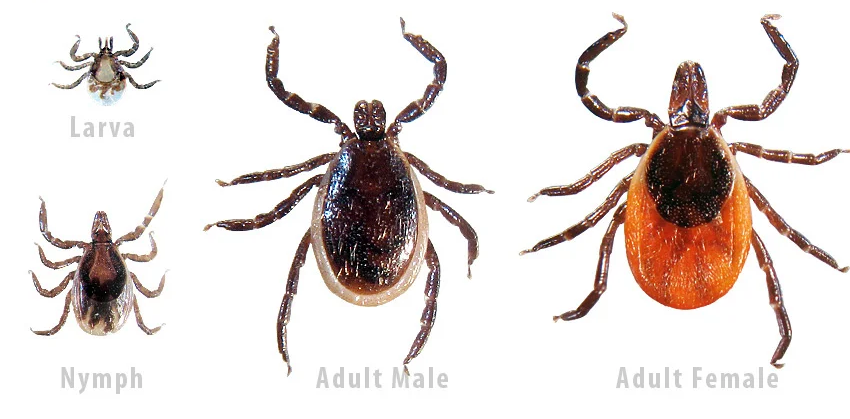Instructions for use
Fine tipped tweezers
(Ideal for removing small ticks)

STEP 1
Grip the tick close to the skin's surface.
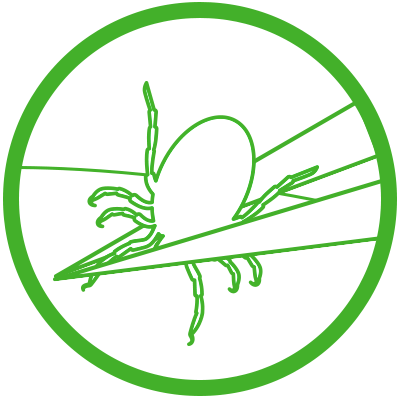
STEP 2
Pull upward with steady, even pressure. NEVER twist or jerk the tick out.
Slotted scoop
(Ideal for removing large ticks)
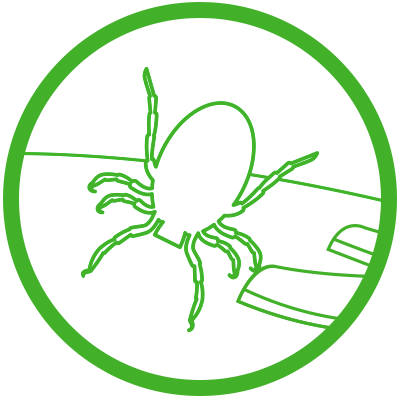
Step 1
Place the slotted scoop against the skin, sliding it under the tick's mouth parts.
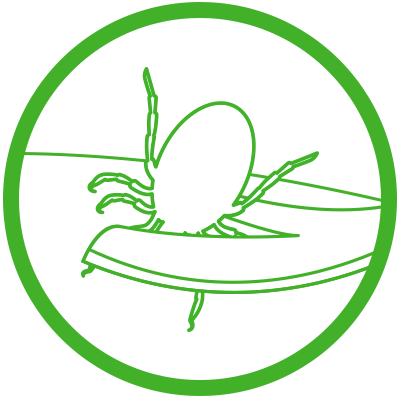
STEP 2
Lift the tick carefully from the skin with steady, even pressure.
Checking for ticks
For People
When checking for ticks, pay special attention to these areas:
- Along your hairline
- Groin
- Around/In the ears
- Legs
- Back of your neck
- Behind the knees
- Armpits
- Between your toes
Use a hand-held or full length mirror to view all parts of your body for ticks.
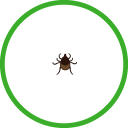
Larva
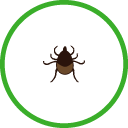
Nymph
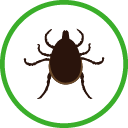
Adult Male
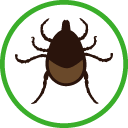
Adult Female
For pets
Examine your pet thoroughly from tail to nose, especially the neck, head, and around the ears as ticks like to embed themselves in these areas. Searching is made easier by separating the fur and examining the skin.
- Under the collar
- Under the tail
- Inside the groin area
- Between the toes
- Under the front legs
- Elbows
- Even on the eyelids!
Some ticks can be the size of a sesame seed.
Some species of ticks are no bigger than a grain of sand.
Common ticks in the usa
Helpful tips
Double sided design
Remove ticks with ease using the only available dual-tipped tick removal device on the market, allowing you to remove ticks from humans & animals with just one tool.
Made for people + pets
Featuring fine-tipped tweezers for removing even the smallest ticks, and a slotted scoop for removing larger ticks.
Removes ticks of all sizes
Unlike regular household tweezers, our reliable tick removal tool detaches ticks safely and effectively and meets CDC guidelines for tick removal.
100 stainless steel
Made from durable stainless steel, our high-quality tick remover can withstand the heat from an autoclave for sterilization.
Compact practical + handy
Out hiking, camping, or traveling? Take your handy Bug Bite Thing Tick Remover for emergency tick removal anytime, anywhere for you or your pets.
Top Ten Things Everyone Should Know About Ticks:
-
Tick bites and tick borne diseases are completely preventable:
There's really only one way you get a tick-transmitted disease, and that's from a tick bite. Reducing tick abundance in your yard where you spend a lot of time, wearing tick-repellent clothing every day, treating pets every month with tick-repellent spot-on products, getting into a habit of doing a quick body scan for attached poppy-seed-sized or larger ticks, and pulling ticks off quickly and safely are all great actions for preventing tick bites. These days, ticks are more than just an annoyance. One bite can make you sick, even change your life! Remember these 10 things, and you'll stay safer.
-
Clothing with built in tick repellent is best for preventing tick bites:
An easy way to avoid tick bites and disease is to wear clothing (shoes, socks, shorts or pants, and a shirt) with permethrin tick-repellent built-in. This strategy can be especially effective for protecting children. Dressing kids in tick-repellent clothes daily is a safe and easy way to keep ticks from biting and transmitting disease. Commercially-treated tick-repellent clothes last through at least 70 washes, while using kits or sprays to treat your current outdoor wardrobe can last through 6 washes. Tick repellent on clothing, not skin, is something everyone needs to know about to stay safe outdoors.
-
The easiest and safest way to remove a tick is with a pointy tweezer:
Think of a tick as a little germ-filled balloon. Squeeze it too hard on its back end, and all the germs get pushed to the front end, which by the way, is attached to you by the tick's straw-like mouthpart. Using really pointy tweezers, it's possible to grab even the poppy-seed-sized nymphs right down next to the skin. The next step is to simply pull the tick out like a splinter. Don't worry if the mouthpart stays in your skin as long as you've got the rest of the tick by its head. Other tick removal methods, like a hot match, Vaseline, dish soap and cotton, or various little key-like devices, don't work as consistently as pointy tweezers on all types of ticks. Remember to save the tick and try to identify it (see #6).
-
Deer tick nymphs look like a poppy seed on your skin:
And with about 1 out of 4 nymphal deer ticks carrying the Lyme disease spirochete and other nasty germs in the northeastern, mid-Atlantic, and upper mid-western U.S., it's important to know what you're really looking for. They're easy to miss, their bites are generally painless, and they have a habit of climbing up (under clothing) and biting in hard-to-see places.
-
For most tick borne diseases you have at least 24 hours to find and remove a Feeding tick before it transmits an infection:
Even a quick daily tick check at bath or shower time can be helpful in finding and removing attached ticks before they can transmit an infection. You'll probably want to check even more carefully if you know you've likely been exposed. Many of the disease- causing microbes transmitted by ticks need a "reactivation" period in the tick once it begins to feed. The germs eventually make their way into the tick's salivary glands, and the tick spits them into you while feeding. Some infections, especially viruses, move into the tick salivary glands faster than others. Lyme disease bacteria take at least 24 hours to invade the tick's saliva.
-
Only deer ticks transmit lyme disease bacteria:
The only way to get Lyme disease is by being bitten by a deer tick or one of its "cousins" found around the world. Deer ticks also are known as blacklegged ticks in the U.S., sheep ticks in Europe, or Taiga ticks in Asia. Dog ticks, Lone Star ticks, and other types of ticks don't seem to be able to transmit Lyme disease. While that's good news, it makes saving any tick that you find biting more important so you can identify it. Doing so may save a lot of unnecessary doctor visits and treatments.
-
Ticks carry disease causing microbes:
Tick-transmitted infections are more common these days than in past decades. With explosive increases in deer populations, extending even into semi-urban areas in the eastern and western U.S., the trend is for increasing abundance and geographic spread of deer ticks and Lone Star ticks, and scientists are finding an ever-increasing list of disease-causing microbes transmitted by these ticks: Lyme disease bacteria, Babesia protozoa, Anaplasma, Ehrlichia, and other rickettsia, even encephalitis-causing viruses, and possibly Bartonella bacteria. Back in the day, tick bites were more of an annoyance, but now a bite is much more likely to make you sick.
-
Ticks can be active even in the winter:
That's right! Adult-stage deer ticks become active every year after the first frost. They're not killed by freezing temperatures, and while other ticks enter a feeding diapause as day lengths get shorter, deer ticks will be active any winter day that the ground is not snow-covered or frozen. This surprises people, especially during a January thaw or early spring day. Remember this fact, and hopefully, you'll never be caught off-guard.
-
All ticks including deer ticks come in small medium and large sizes:
Ticks hatch from eggs and develop through three active (and blood-feeding) stages: larvae (small-the size of sand grains), nymphs (medium-the size of poppy seeds), and adults (large-the size of apple seeds). If you see them bigger, they're probably partially full or full of blood.
-
Ticks crawl up:
Ticks don't jump, fly, or drop from trees onto your head and back. If you find one attached there, it most likely latched onto your foot or leg and crawled up over your entire body. Ticks are "programmed" to try and attach around your head or ears. On their normal hosts, ticks also usually crawl up; they want to blood feed around the head, neck, and ears of their host, where the skin is thinner, and hosts have more trouble grooming.
FAQ
As the University of Rhode Island Tick Encounter Resource Center (TERC) explains: Ticks actually numb the area before they bite. Their saliva contains a numbing agent called kinases so that you won't feel the bite. The area will remain numb the whole time the tick is feeding on a host's blood.
If you have been bitten previously, you may notice a small red bite mark, which can be itchy. If there is no tick at such a site, you may have already scratched it off without knowing it.
There are a number of places listed on the Tick Encounter Tick Testing page. You can use their Tick Identification Chart to confirm that your tick is an adult deer tick. According to the Centers for Disease Control (CDC), Deer ticks are the only tick species that transmit Lyme in the Northeastern, Mid-Atlantic, and North-Central United States.
Ticks can only penetrate your skin with their mouth parts, which are called hypostomes. Their bodies are never embedded under the skin. Don't wait to see a doctor to remove an engorged, biting tick. It is easy to remove a tick safely by using the Bug Bite Thing Tick Remover.
Don't worry if the head stays in; just disinfect the area with rubbing alcohol. You also might want to consider identifying and testing the tick for infection.
The safest way to remove a tick is with a pointed tweezer — like the Bug Bite Thing Tick Remover. Grasp the tick as close to the skin as possible, and pull it straight up in a firm but slow and steady motion until it pops out of the skin. Clean the bite area and tool thoroughly with soap and water or an alcohol wipe, and consider saving the tick for testing.
First, you should know that Blacklegged "Deer" Ticks don't travel very far on their own, perhaps only one or two meters. However, they do get moved around by animals. Pets, particularly cats, are notorious for picking up a tick outside and then bringing it inside to humans.
If the tick attaches to your cat or dog's fur, it will not typically leave it, but if the animal comes inside or you pick it up, loose ticks crawling on the animal's fur can easily transfer over to you. One helpful suggestion: comb or brush your dog or cat before they come into the house.
It depends on how recently you were bit. Within three days of being bitten by a tick, many people will develop a red spot that never expands to bigger than a dime. This is just an allergic reaction to the saliva that the tick is spitting into you.
Watch the site, however. If the red spot grows in size over a period of a week or so to bigger than two inches, then it is likely to be a sign that you are infected with the Lyme Disease agent. However, only about 35 percent of people who are infected with Lyme will develop the bullseye rash, and many people who get Lyme Disease never recall getting a tick bite.
No! Ticks can only embed their hypostome or mouthpart into the skin. Their palps, which cover the hypostome to protect it when the tick is not feeding, fold back and prevent the tick from going any further into your skin.
During the Fall and early Spring in the Northeast, Mid-Atlantic and Upper Midwest, ticks that look like a "corn kernel" are most likely to be partially engorged female deer ticks -- most likely attached for about three days to look like a corn kernel. Their body generally looks pale at this stage, and they have not started to swell up big.
If your pet has the Lyme disease vaccine, it may be fine. However, three days are long enough for a deer tick to transmit Lyme Disease bacteria and/or another serious disease called Anaplasmosis. You could give your vet a call and see if they will take any prophylactic measures.
According to the Centers for Disease Control (CDC), Blacklegged "Deer" Ticks are the only tick species that transmit Lyme Disease in the Northeastern, Mid-Atlantic, and North-Central United States. However, American Dog ticks can be infected with Rocky Mountain Spotted Fever rickettsia, other less pathogenic rickettsiae, Colorado Tick Fever virus, and rarely, with the agent of tularemia. Hopefully, the only concern is a bit of a tick bite.
CAUTION: If you or your pet become sick or develop a rash or fever after a tick bite, seek medical attention immediately.
In people that have previously been bitten by the same type of tick, there often is a histamine-mediated hypersensitivity reaction that occurs within 20-40 hours of another tick bite. It's your body making a reaction to a foreign substance (like tick saliva) that it has seen before. In some people, it can become quite severe--localized anaphylaxis. It would be a good idea to see your primary care provider and be sure to mention your tick bite.
The length of time a tick stays attached depends on the tick species, tick life stage, and host immunity. It also depends on whether you do a daily tick check. Generally, if undisturbed, larvae remain attached and feed for about three days, nymphs for three to four days, and adult females for seven to ten days. Blacklegged "Deer" ticks feed a day or so faster than Lone Star ticks and American dog ticks. You might be interested in the Tick Growth Comparison Charts from TickEncounter. Ticks change their appearance pretty dramatically as they feed - which can make identifying them challenging.
Host immunity also can impact the duration of tick attachment as well. Prior sensitization to specific proteins in tick saliva can make it harder for ticks to ingest blood. Sometimes it causes them to stay attached a bit longer, but more commonly, it makes the host itch, and frequently the tick is removed by scratching.
